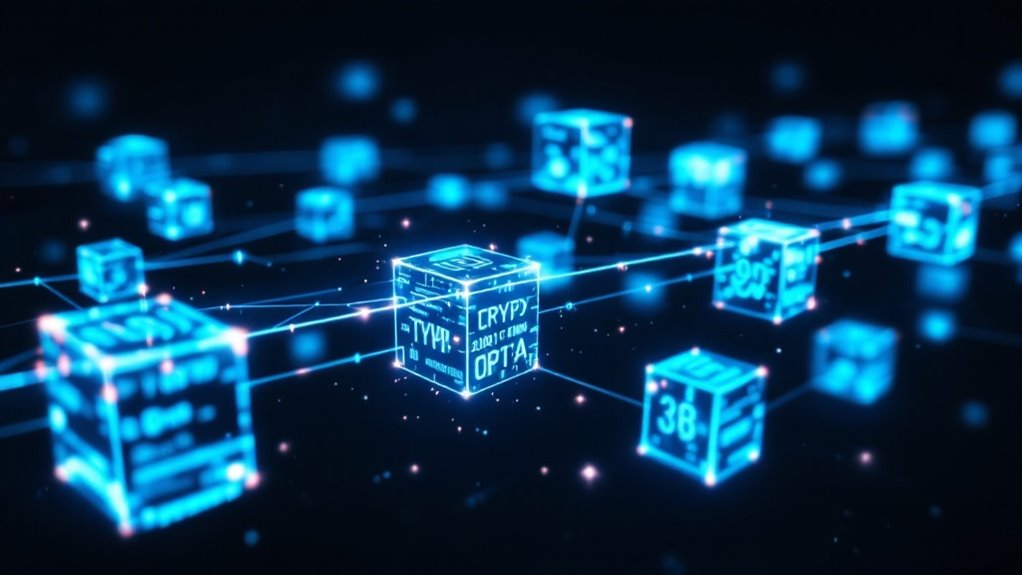Blockchain technology revolutionizes how we record and verify digital transactions through a decentralized network of computers. Like a digital fingerprint that can't be erased, it creates an immutable chain of information secured by sophisticated cryptography. Each transaction joins others in time-stamped blocks, verified by nodes across the network without traditional intermediaries. From supply chain tracking to healthcare records, blockchain's applications extend far beyond cryptocurrencies. This transformative technology continues to reshape industries while sparking both excitement and skepticism.

Innovation has sparked a quiet revolution in how we track, verify, and exchange value across the digital landscape. At its core, blockchain technology represents a distributed digital ledger that records transactions in an immutable chain of chronological blocks, much like a digital fingerprint that can never be erased. This groundbreaking system eliminates the need for traditional intermediaries, allowing direct peer-to-peer interactions secured by sophisticated cryptography.
Picture a vast network of computers, each holding an identical copy of the ledger, working together like countless notaries comparing their records in real-time. When someone initiates a transaction, these computers, called nodes, spring into action to verify its legitimacy. Once validated, the transaction joins others in a block, which is then cryptographically linked to previous blocks, forming an unbreakable chain of digital truth. In fact, Bitcoin's network requires approximately ten minutes to validate and add a new block of transactions.
Blockchain's distributed ledger creates an intricate web of trust, where each node safeguards the network's unbreakable digital history.
The technology comes in various flavors, each serving different needs. Public blockchains, like Bitcoin and Ethereum, operate like bustling digital town squares where anyone can participate. Private and consortium blockchains, meanwhile, function more like exclusive clubs with restricted access, perfect for businesses and organizations requiring controlled environments. Some networks even combine these approaches, creating hybrid solutions that balance openness with privacy. Smart contracts automate financial services and eliminate the need for intermediaries in various transactions. Each block is secured through a unique cryptographic hash that ensures the data's integrity and links it to the previous block in the chain.
Beyond cryptocurrencies, blockchain's applications stretch far and wide. Supply chain managers use it to track products from factory floor to store shelf, while healthcare providers secure patient records with unprecedented reliability. Even voting systems are being reimagined through blockchain's lens, promising more transparent and tamper-resistant elections.
Despite its promise, blockchain technology faces notable hurdles. Public networks struggle with scalability issues, sometimes processing transactions as slowly as a vintage dial-up modem. Energy consumption concerns loom large, particularly in proof-of-work systems that require massive computational power.
Regulatory uncertainty and technical complexity also pose adoption challenges. Yet, as the technology matures, innovative solutions emerge to address these limitations, suggesting that blockchain's quiet revolution may just be getting started.
Frequently Asked Questions
How Long Does It Take to Mine One Bitcoin?
Mining one Bitcoin takes varying times depending on hardware and network conditions. With current difficulty and a standard ASIC miner, it could take several years to mine one Bitcoin independently.
Can Blockchain Technology Be Hacked or Compromised?
While blockchain technology is highly secure, it can be compromised through 51% attacks, smart contract vulnerabilities, phishing schemes, and routing attacks. However, proper security measures and protocols greatly reduce these risks.
Which Programming Languages Are Commonly Used for Blockchain Development?
Common blockchain programming languages include Solidity for Ethereum smart contracts, Java for Hyperledger, Python for prototyping, C++ for Bitcoin core development, and emerging languages like Rust and Go for various platforms.
How Much Energy Does Blockchain Mining Consume Globally?
Blockchain mining consumes approximately 160 terawatt-hours of electricity annually, equivalent to 0.5% of global electricity consumption. This energy usage matches Argentina's national consumption and represents 2% of USA's annual electricity demand.
What Happens to Lost Cryptocurrency Keys in Blockchain Transactions?
Lost cryptocurrency private keys render associated funds permanently inaccessible. The coins remain visible on the blockchain but cannot be spent, effectively removing them from circulation and potentially increasing the value of remaining coins.









